
Illustrative Math Alignment: Grade 7 Unit 7
Expressions, Equations, and Inequalities
Lesson 23: Applications of Expressions
Use the following Media4Math resources with this Illustrative Math lesson.
| Thumbnail Image | Title | Body | Curriculum Topic |
|---|---|---|---|

|
Lesson Plan--Rational Expressions--Lesson 1--Introduction to Rational Expressions | Lesson Plan: Introduction to Rational Expressions In this lesson, students will explore the fundamentals of rational expressions, a key concept in algebra. They will learn how to identify, simplify, and evaluate rational expressions by applying their understanding of fractions and algebraic operations. This lesson introduces students to the structure of rational expressions, emphasizing their similarities to numerical fractions and their role in algebraic problem-solving. Key concepts covered in this lesson include: |
Rational Expressions |

|
Lesson Plan--Rational Expressions--Lesson 2--Simplifying Rational Expressions | Lesson Plan: Simplifying Rational Expressions In this high school algebra lesson, students will learn how to simplify rational expressions by applying factoring techniques and identifying common factors. Rational expressions, which are algebraic fractions, can often be simplified by reducing common terms in the numerator and denominator. This lesson provides a step-by-step approach to recognizing and simplifying these expressions while reinforcing key algebraic concepts. Key concepts covered in this lesson include: |
Rational Expressions |

|
Lesson Plan--Rational Expressions--Lesson 3--Adding and Subtracting Rational Expressions | Lesson Plan: Adding and Subtracting Rational Expressions In this high school algebra lesson, students will learn how to add and subtract rational expressions by finding common denominators and simplifying algebraic fractions. Mastering these operations is essential for working with complex rational equations and solving real-world problems involving algebraic fractions. This lesson builds on prior knowledge of simplifying rational expressions and applying fraction rules. Key concepts covered in this lesson include: |
Rational Expressions |

|
Lesson Plan--Rational Expressions--Lesson 4--Multiplying and Dividing Rational Expressions | Lesson Plan: Multiplying and Dividing Rational Expressions In this high school algebra lesson, students will learn how to multiply and divide rational expressions by applying fraction rules and algebraic simplification techniques. Understanding these operations is essential for working with complex algebraic expressions and solving rational equations. This lesson builds on students’ knowledge of simplifying rational expressions and introduces step-by-step strategies for performing multiplication and division. Key concepts covered in this lesson include: |
Rational Expressions |

|
Lesson Plan--Rational Expressions--Lesson 5--Complex Rational Expressions | Lesson Plan: Complex Rational Expressions In this high school algebra lesson, students will learn how to simplify complex rational expressions—fractions that contain other fractions in the numerator, denominator, or both. Mastering this topic is essential for working with advanced algebraic expressions and preparing for higher-level math courses, including calculus. Key concepts covered in this lesson include: |
Rational Expressions |
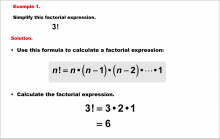
|
Math Example--Combinatorics--Factorial Expressions: Example 1 | Math Example--Combinatorics--Factorial Expressions: Example 1
This is part of a collection of math examples that focus on combinatorics and factorial expressions. |
Data Analysis and Combinatorics |

|
Math Example--Combinatorics--Factorial Expressions: Example 10 | Math Example--Combinatorics--Factorial Expressions: Example 10
This is part of a collection of math examples that focus on combinatorics and factorial expressions. |
Combinatorics |
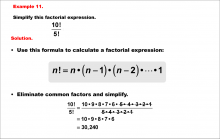
|
Math Example--Combinatorics--Factorial Expressions: Example 11 | Math Example--Combinatorics--Factorial Expressions: Example 11
This is part of a collection of math examples that focus on combinatorics and factorial expressions. |
Combinatorics |

|
Math Example--Combinatorics--Factorial Expressions: Example 12 | Math Example--Combinatorics--Factorial Expressions: Example 12
This is part of a collection of math examples that focus on combinatorics and factorial expressions. |
Combinatorics |
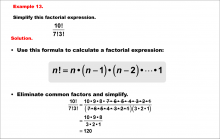
|
Math Example--Combinatorics--Factorial Expressions: Example 13 | Math Example--Combinatorics--Factorial Expressions: Example 13
This is part of a collection of math examples that focus on combinatorics and factorial expressions. |
Combinatorics |
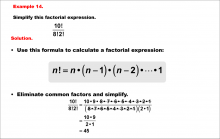
|
Math Example--Combinatorics--Factorial Expressions: Example 14 | Math Example--Combinatorics--Factorial Expressions: Example 14
This is part of a collection of math examples that focus on combinatorics and factorial expressions. |
Combinatorics |

|
Math Example--Combinatorics--Factorial Expressions: Example 2 | Math Example--Combinatorics--Factorial Expressions: Example 2
This is part of a collection of math examples that focus on combinatorics and factorial expressions. |
Combinatorics |
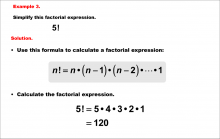
|
Math Example--Combinatorics--Factorial Expressions: Example 3 | Math Example--Combinatorics--Factorial Expressions: Example 3
This is part of a collection of math examples that focus on combinatorics and factorial expressions. |
Combinatorics |
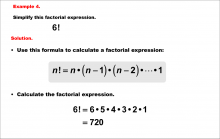
|
Math Example--Combinatorics--Factorial Expressions: Example 4 | Math Example--Combinatorics--Factorial Expressions: Example 4
This is part of a collection of math examples that focus on combinatorics and factorial expressions. |
Combinatorics |
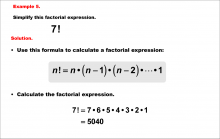
|
Math Example--Combinatorics--Factorial Expressions: Example 5 | Math Example--Combinatorics--Factorial Expressions: Example 5
This is part of a collection of math examples that focus on combinatorics and factorial expressions. |
Combinatorics |
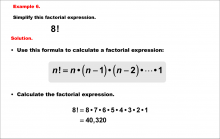
|
Math Example--Combinatorics--Factorial Expressions: Example 6 | Math Example--Combinatorics--Factorial Expressions: Example 6
This is part of a collection of math examples that focus on combinatorics and factorial expressions. |
Combinatorics |

|
Math Example--Combinatorics--Factorial Expressions: Example 7 | Math Example--Combinatorics--Factorial Expressions: Example 7
This is part of a collection of math examples that focus on combinatorics and factorial expressions. |
Combinatorics |
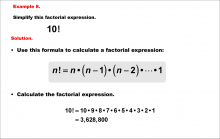
|
Math Example--Combinatorics--Factorial Expressions: Example 8 | Math Example--Combinatorics--Factorial Expressions: Example 8
This is part of a collection of math examples that focus on combinatorics and factorial expressions. |
Combinatorics |
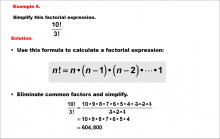
|
Math Example--Combinatorics--Factorial Expressions: Example 9 | Math Example--Combinatorics--Factorial Expressions: Example 9
This is part of a collection of math examples that focus on combinatorics and factorial expressions. |
Combinatorics |
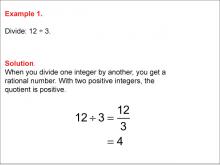
|
Math Example--Numerical Expressions--Dividing Integers: Example 1 | Math Example--Numerical Expressions--Dividing Integers: Example 1TopicNumerical Expressions DescriptionThis example demonstrates the division of two positive integers: 12 divided by 3. The solution shows that when dividing one integer by another, the result is a rational number. In this case, with two positive integers, the quotient is positive. The calculation is presented as 12 ÷ 3 = 12 / 3 = 4. |
Numerical Expressions |
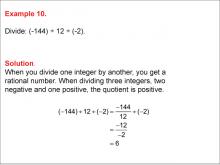
|
Math Example--Numerical Expressions--Dividing Integers: Example 10 | Math Example--Numerical Expressions--Dividing Integers: Example 10TopicNumerical Expressions DescriptionThis example demonstrates the division of three integers: (-144) ÷ 12 ÷ (-2). The solution shows that dividing three integers, two negative and one positive, results in a positive quotient. The calculation is presented step-by-step: (-144) ÷ 12 ÷ (-2) = -12 / -2 = 6. |
Numerical Expressions |

|
Math Example--Numerical Expressions--Dividing Integers: Example 11 | Math Example--Numerical Expressions--Dividing Integers: Example 11TopicNumerical Expressions DescriptionThis example demonstrates the division of three integers: (-150) ÷ (-5) ÷ 3. The solution shows that dividing three integers, two negative and one positive, results in a positive quotient. The calculation is presented step-by-step: (-150) ÷ (-5) ÷ 3 = 30 / 3 = 10. |
Numerical Expressions |

|
Math Example--Numerical Expressions--Dividing Integers: Example 12 | Math Example--Numerical Expressions--Dividing Integers: Example 12TopicNumerical Expressions DescriptionThis example illustrates the division of three negative integers: -108 ÷ (-2) ÷ (-6). The solution demonstrates that dividing three negative integers results in a negative quotient. The calculation is presented step-by-step: (-108 / -2) / -6 = 54 / -6 = -9. |
Numerical Expressions |
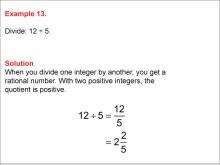
|
Math Example--Numerical Expressions--Dividing Integers: Example 13 | Math Example--Numerical Expressions--Dividing Integers: Example 13TopicNumerical Expressions DescriptionThis example demonstrates the division of two positive integers: 12 ÷ 5. The solution shows that dividing two positive integers results in a positive quotient, which in this case is a mixed number. The calculation is presented as: 12 / 5 = 2 2/5. |
Numerical Expressions |
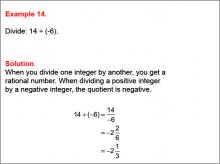
|
Math Example--Numerical Expressions--Dividing Integers: Example 14 | Math Example--Numerical Expressions--Dividing Integers: Example 14TopicNumerical Expressions DescriptionThis example illustrates the division of a positive integer by a negative integer: 14 ÷ (-6). The solution demonstrates that dividing a positive by a negative results in a negative quotient, which in this case is a mixed number. The calculation is presented as: 14 / -6 = -2 1/3. |
Numerical Expressions |
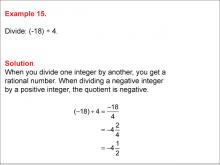
|
Math Example--Numerical Expressions--Dividing Integers: Example 15 | Math Example--Numerical Expressions--Dividing Integers: Example 15TopicNumerical Expressions DescriptionThis example demonstrates the division of a negative integer by a positive integer: -18 ÷ 4. The solution shows that dividing a negative by a positive results in a negative quotient, which in this case is a fraction. The calculation is presented as: -18 / 4 = -9/2 = -4 1/2. |
Numerical Expressions |
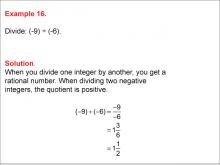
|
Math Example--Numerical Expressions--Dividing Integers: Example 16 | Math Example--Numerical Expressions--Dividing Integers: Example 16TopicNumerical Expressions DescriptionThis example illustrates the division of two negative integers: (-9) ÷ (-6). The solution demonstrates that dividing two negative integers results in a positive fraction. The calculation is presented step-by-step: (-9) ÷ (-6) = -9 / -6 = -3 / -2 = 1 1/2. |
Numerical Expressions |
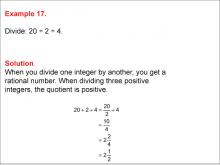
|
Math Example--Numerical Expressions--Dividing Integers: Example 17 | Math Example--Numerical Expressions--Dividing Integers: Example 17TopicNumerical Expressions DescriptionThis example demonstrates the division of three positive integers: 20 ÷ 2 ÷ 4. The solution shows that dividing three positive integers results in a positive mixed number quotient. The calculation is presented step-by-step: 20 ÷ 2 ÷ 4 = 20 / 2 / 4 = 10 / 4 = 2 1/2. |
Numerical Expressions |

|
Math Example--Numerical Expressions--Dividing Integers: Example 18 | Math Example--Numerical Expressions--Dividing Integers: Example 18TopicNumerical Expressions DescriptionThis example illustrates the division of three integers: 48 ÷ 6 ÷ (-3). The solution demonstrates that dividing two positive integers and one negative integer results in a negative mixed number quotient. The calculation is presented step-by-step: 48 ÷ 6 ÷ (-3) = 48 / 6 / (-3) = 8 / (-3) = -2 2/3. |
Numerical Expressions |
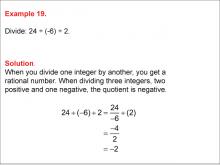
|
Math Example--Numerical Expressions--Dividing Integers: Example 19 | Math Example--Numerical Expressions--Dividing Integers: Example 19TopicNumerical Expressions DescriptionThis example demonstrates the division of three integers: 24 ÷ (-6) ÷ 2. The solution shows that dividing two positive integers and one negative integer results in a negative quotient. The calculation is presented step-by-step: 24 ÷ (-6) ÷ 2 = 24 / (-6) / (2) = -4 / 2 = -2. |
Numerical Expressions |
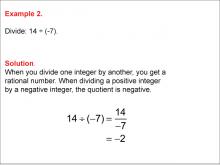
|
Math Example--Numerical Expressions--Dividing Integers: Example 2 | Math Example--Numerical Expressions--Dividing Integers: Example 2TopicNumerical Expressions DescriptionThis example illustrates the division of a positive integer by a negative integer: 14 divided by -7. The solution demonstrates that when dividing one integer by another, the result is a rational number. In this case, when dividing a positive integer by a negative integer, the quotient is negative. The calculation is presented as 14 ÷ (-7) = 14 / -7 = -2. |
Numerical Expressions |
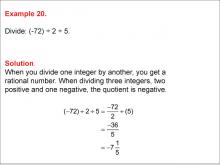
|
Math Example--Numerical Expressions--Dividing Integers: Example 20 | Math Example--Numerical Expressions--Dividing Integers: Example 20TopicNumerical Expressions DescriptionThis example demonstrates the division of three integers: (-72) / 2 / 5. The solution shows that dividing a negative integer by two positive integers results in a negative mixed number quotient. The calculation is presented step-by-step: (-72) / 2 / 5 = -72 / (2 * 5) = -36 / 5 = -7 1/5. |
Numerical Expressions |
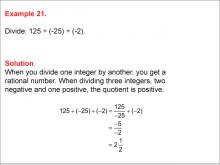
|
Math Example--Numerical Expressions--Dividing Integers: Example 21 | Math Example--Numerical Expressions--Dividing Integers: Example 21TopicNumerical Expressions DescriptionThis example demonstrates the division of three integers: 125 / (-25) / (-2). The solution shows that dividing a positive integer by two negative integers results in a positive mixed number quotient. The calculation is presented step-by-step: 125 / (-25) / (-2) = 125 / (25 * -2) = -5 / -2 = 2 1/2. |
Numerical Expressions |
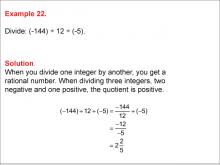
|
Math Example--Numerical Expressions--Dividing Integers: Example 22 | Math Example--Numerical Expressions--Dividing Integers: Example 22TopicNumerical Expressions DescriptionThis example illustrates the division of three integers: (-144) / 12 / (-5). The solution demonstrates that dividing a negative integer by a positive integer and then by a negative integer results in a positive fraction. The calculation is presented step-by-step: (-144) / 12 / (-5) = -144 / (12 * -5) = -12 / -5 = 2 2/5. |
Numerical Expressions |
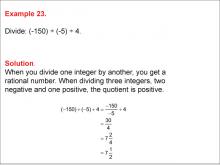
|
Math Example--Numerical Expressions--Dividing Integers: Example 23 | Math Example--Numerical Expressions--Dividing Integers: Example 23TopicNumerical Expressions DescriptionThis example demonstrates the division of three integers: (-150) / (-5) / 4. The solution shows that dividing a negative integer by a negative integer and then by a positive integer results in a positive mixed number quotient. The calculation is presented step-by-step: (-150) / (-5) / 4 = -150 / -5 / 4 = 30 / 4 = 7 1/2. |
Numerical Expressions |
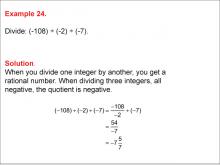
|
Math Example--Numerical Expressions--Dividing Integers: Example 24 | Math Example--Numerical Expressions--Dividing Integers: Example 24TopicNumerical Expressions DescriptionThis example illustrates the division of three negative integers: (-108) ÷ (-2) ÷ (-7). The solution demonstrates that dividing three negative integers results in a negative mixed number quotient. The calculation is presented step-by-step: (-108) ÷ (-2) ÷ (-7) = -108 / -2 ÷ (-7) = 54 / -7 = -7 5/7. |
Numerical Expressions |

|
Math Example--Numerical Expressions--Dividing Integers: Example 3 | Math Example--Numerical Expressions--Dividing Integers: Example 3TopicNumerical Expressions DescriptionThis example demonstrates the division of a negative integer by a positive integer: -18 divided by 6. The solution shows that when dividing one integer by another, the result is a rational number. In this case, when dividing a negative integer by a positive integer, the quotient is negative. The calculation is presented as (-18) ÷ 6 = -18 / 6 = -3. |
Numerical Expressions |
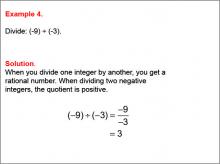
|
Math Example--Numerical Expressions--Dividing Integers: Example 4 | Math Example--Numerical Expressions--Dividing Integers: Example 4TopicNumerical Expressions DescriptionThis example illustrates the division of two negative integers: -9 divided by -3. The solution demonstrates that when dividing one integer by another, the result is a rational number. In this case, when dividing two negative integers, the quotient is positive. The calculation is presented as (-9) ÷ (-3) = -9 / -3 = 3. |
Numerical Expressions |
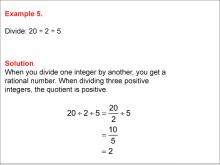
|
Math Example--Numerical Expressions--Dividing Integers: Example 5 | Math Example--Numerical Expressions--Dividing Integers: Example 5TopicNumerical Expressions DescriptionThis example demonstrates the division of three positive integers: 20 ÷ 2 ÷ 5. The solution shows that dividing three positive integers results in a positive quotient. The calculation is presented step-by-step: 20 ÷ 2 ÷ 5 = 20 / 2 ÷ 5 = 10 / 5 = 2. |
Numerical Expressions |

|
Math Example--Numerical Expressions--Dividing Integers: Example 6 | Math Example--Numerical Expressions--Dividing Integers: Example 6TopicNumerical Expressions DescriptionThis example demonstrates the division of three integers: 48 ÷ 6 ÷ (-4). The solution shows that dividing three integers, two positive and one negative, results in a negative quotient. The calculation is presented step-by-step: 48 ÷ 6 ÷ (-4) = 48 / 6 ÷ (-4) = 8 / -4 = -2. |
Numerical Expressions |
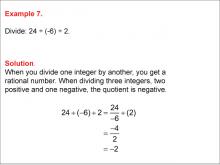
|
Math Example--Numerical Expressions--Dividing Integers: Example 7 | Math Example--Numerical Expressions--Dividing Integers: Example 7TopicNumerical Expressions DescriptionThis example illustrates the division of three integers: 24 ÷ (-6) ÷ 2. The solution demonstrates that dividing three integers, two positive and one negative, results in a negative quotient. The calculation is presented step-by-step: 24 ÷ (-6) ÷ 2 = -4 / 2 = -2. |
Numerical Expressions |
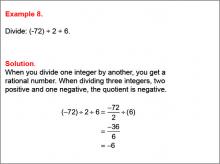
|
Math Example--Numerical Expressions--Dividing Integers: Example 8 | Math Example--Numerical Expressions--Dividing Integers: Example 8TopicNumerical Expressions DescriptionThis example demonstrates the division of three integers: (-72) ÷ 2 ÷ 6. The solution shows that dividing three integers, two positive and one negative, results in a negative quotient. The calculation is presented step-by-step: (-72) ÷ 2 ÷ 6 = -72 / 2 ÷ 6 = -36 / 6 = -6. |
Numerical Expressions |
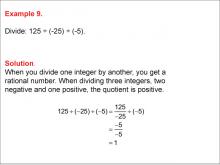
|
Math Example--Numerical Expressions--Dividing Integers: Example 9 | Math Example--Numerical Expressions--Dividing Integers: Example 9TopicNumerical Expressions DescriptionThis example illustrates the division of three integers: 125 ÷ (-25) ÷ (-5). The solution demonstrates that dividing three integers, two negative and one positive, results in a positive quotient. The calculation is presented step-by-step: 125 ÷ (-25) ÷ (-5) = -5 / -5 = 1. |
Numerical Expressions |
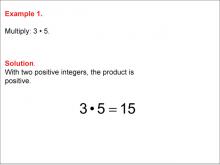
|
Math Example--Numerical Expressions--Multiplying Integers: Example 1 | Math Example--Numerical Expressions--Multiplying Integers: Example 1TopicNumerical Expressions DescriptionExample 1 demonstrates the multiplication of two positive integers: 3 × 5. The solution shows that when multiplying two positive numbers, the result is always positive. In this case, 3 × 5 = 15. Numerical expressions are fundamental in mathematics, representing values through various operations like addition, subtraction, multiplication, and division. This collection of examples illustrates different scenarios of integer multiplication, helping students recognize patterns and develop strategies for solving numerical problems effectively. |
Numerical Expressions |

|
Math Example--Numerical Expressions--Multiplying Integers: Example 10 | Math Example--Numerical Expressions--Multiplying Integers: Example 10TopicNumerical Expressions DescriptionExample 10 illustrates the multiplication of three integers: -5, 4, and -6. The solution demonstrates that when multiplying three integers with two negative numbers and one positive number, the result is positive. In this case, (-5) × 4 × (-6) = 120. |
Numerical Expressions |
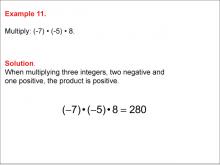
|
Math Example--Numerical Expressions--Multiplying Integers: Example 11 | Math Example--Numerical Expressions--Multiplying Integers: Example 11TopicNumerical Expressions DescriptionExample 11 shows the multiplication of three integers: -7, -5, and 8. The solution demonstrates that when multiplying three integers with two negative numbers and one positive number, the result is positive. In this case, (-7) × (-5) × 8 = 280. |
Numerical Expressions |
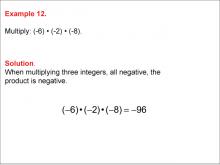
|
Math Example--Numerical Expressions--Multiplying Integers: Example 12 | Math Example--Numerical Expressions--Multiplying Integers: Example 12TopicNumerical Expressions DescriptionExample 12 demonstrates the multiplication of three negative integers: -6, -2, and -8. The solution shows that when multiplying three negative numbers, the result is negative. In this case, (-6) × (-2) × (-8) = -96. This collection of examples covers various scenarios of integer multiplication, helping students understand the rules governing the multiplication of positive and negative numbers. By presenting different combinations of negative integers, students can recognize patterns and develop a solid foundation for more complex mathematical operations. |
Numerical Expressions |
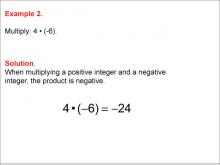
|
Math Example--Numerical Expressions--Multiplying Integers: Example 2 | Math Example--Numerical Expressions--Multiplying Integers: Example 2TopicNumerical Expressions DescriptionExample 2 illustrates the multiplication of a positive integer by a negative integer: 4 × (-6). The solution demonstrates that when multiplying a positive number by a negative number, the result is always negative. In this case, 4 × (-6) = -24. This collection of examples covers various scenarios of integer multiplication, helping students understand the rules governing the multiplication of positive and negative numbers. By presenting different combinations, students can recognize patterns and develop a solid foundation for more complex mathematical operations. |
Numerical Expressions |
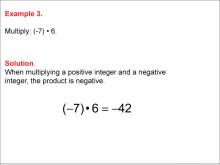
|
Math Example--Numerical Expressions--Multiplying Integers: Example 3 | Math Example--Numerical Expressions--Multiplying Integers: Example 3TopicNumerical Expressions DescriptionExample 3 demonstrates the multiplication of a negative integer by a positive integer: (-7) × 6. The solution shows that when multiplying a negative number by a positive number, the result is always negative. In this case, (-7) × 6 = -42. This collection of examples explores various scenarios of integer multiplication, helping students understand the rules governing the multiplication of positive and negative numbers. By presenting different combinations, students can recognize patterns and develop a solid foundation for more complex mathematical operations. |
Numerical Expressions |
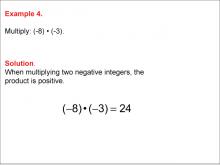
|
Math Example--Numerical Expressions--Multiplying Integers: Example 4 | Math Example--Numerical Expressions--Multiplying Integers: Example 4TopicNumerical Expressions DescriptionExample 4 shows the multiplication of two negative integers: (-8) × (-3). The solution demonstrates that when multiplying two negative numbers, the result is always positive. In this case, (-8) × (-3) = 24. This collection of examples covers various scenarios of integer multiplication, helping students understand the rules governing the multiplication of positive and negative numbers. By presenting different combinations, students can recognize patterns and develop a solid foundation for more complex mathematical operations. |
Numerical Expressions |